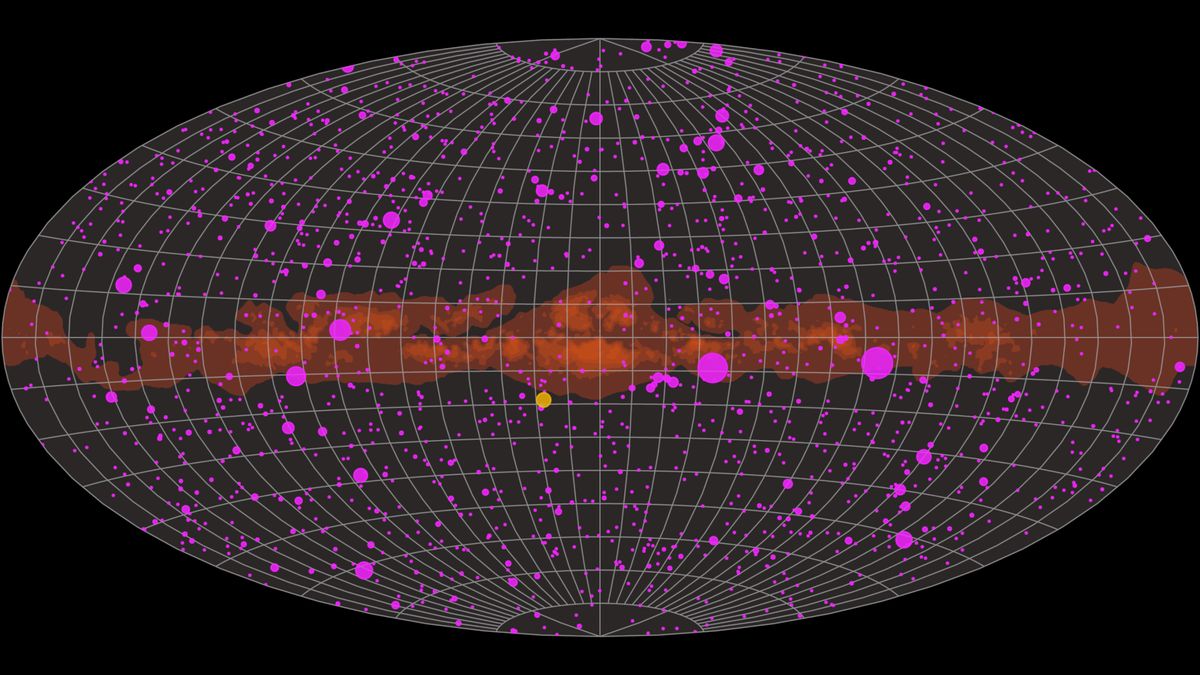A brand new NASA animation reveals what the sky over Earth would appear to be to people if we had advanced to see high-energy gamma-ray mild relatively than simply the seen mild spectrum.
The animation represents a cosmic firework show created as Earth’s atmosphere is belted by gamma rays from astrophysical sources and highly effective cosmic occasions.
The animation reveals a frenzy of gamma-ray exercise between February 2022 to February 2023. Every body of the animation reveals a three-day interval of commentary, with a number of the sources fluctuating in gamma rays all through your complete yr.
Associated: What is a gamma-ray burst?
The pulsing magenta circles within the animation present 1,500 gamma-ray detections rising and shrinking in measurement to symbolize how every supply intensifies and dims over time. The yellow circle swooping throughout the animation traces the trail of the sun, and the thick orange band represents the central airplane of our Milky Way galaxy, a constant producer of gamma rays.
The footage was created utilizing knowledge collected by the Massive Space Telescope (LAT) aboard NASA’s Fermi Gamma-ray Space Telescope, which has been inspecting the gamma-ray sky from house for practically 15 years. Past the animation, the info is curated in a publicly out there and continually updated interactive library (opens in new tab) that’s the work of a world crew of scientists.
LAT scans your complete sky each three hours. recognizing gamma rays with energies starting from 20 million to over 300 billion electron volts. These are extremely high-energy photons; seen mild photons largely fall between 2 to three electron volts.
“We had been impressed to place this database collectively by astronomers who examine galaxies and wished to check seen and gamma-ray mild curves over very long time scales,” Daniel Kocevski, repository co-author and an astrophysicist at NASA’s Marshall House Flight Middle in Huntsville, Alabama, said in a statement (opens in new tab). “We had been getting requests to course of one object at a time. Now the scientific neighborhood has entry to all of the analyzed knowledge for the entire catalog.”
Blazars, gamma rays and galaxies
Over 90% of the cosmic firework gamma-rays within the animation originate from energetic galaxies referred to as “blazars,” through which feeding supermassive black holes blast out jets of fabric and radiation instantly towards Earth.
Supermassive black holes are discovered on the coronary heart of just about each giant galaxy, and whereas a few of these cosmic monsters, resembling Sagittarius A* (Sgr A*) on the coronary heart of the Milky Manner, are comparatively quiet, others are greedily feeding on materials such because the fuel and dirt that surrounds them.
As this fuel and dirt spirals inward, it kinds an accretion disc across the black gap and generates highly effective electromagnetic radiation. This ends in these feeding black holes powering what astronomers name “energetic galactic nuclei” (AGN).
An AGN is a area of a galaxy so luminous it will probably outshine each star in the remainder of that galaxy mixed, despite the fact that the AGN itself might be no wider than our solar system. AGNs additionally blast out jets of fabric that transfer at near-light speeds, stretch for 1000’s of light-years and might be seen in a spread of sunshine wavelengths, together with radio waves, X-rays and gamma-rays.
Blazars, which account for the overwhelming majority of the gamma-ray sources seen within the new NASA animation, are a kind of AGN whose highly effective jets are aimed instantly at Earth. These jets are studied at ground-based observatories, just like the U.S. Nationwide Science Basis’s IceCube Neutrino Observatory in Antarctica, which might be designed to detect high-energy particles.
LAT, Fermi’s major science instrument, has been a significant a part of the examine of blazars. The instrument’s observations have allowed scientists to catalog AGNs and assess their whole power output and spectra adjustments on timescales starting from lower than an hour to a few years.
LAT knowledge will also be mixed with measurements of neutrinos, in an instance of a burgeoning analysis subject referred to as “multimessenger astronomy.”
“In 2018, astronomers introduced a candidate joint detection of gamma rays and a high-energy particle referred to as a neutrino from a blazar for the primary time, due to Fermi LAT and IceCube,” mentioned repository co-author Michela Negro, an astrophysicist on the College of Maryland, Baltimore County and NASA’s Goddard House Flight Middle in Maryland. “Having the historic mild curve database might result in new multimessenger insights into previous occasions.”
The gamma-ray repository is accessible here (opens in new tab), and a paper relating to the analysis was printed in The Astrophysical Journal Supplement Series (opens in new tab).
Observe us on Twitter @Spacedotcom (opens in new tab) or on Facebook (opens in new tab).

